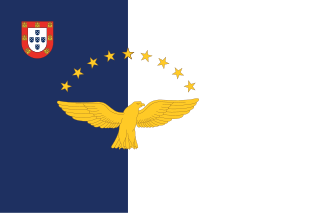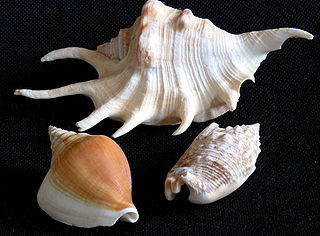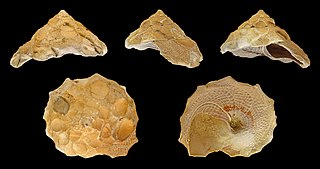
The Azores, officially the Autonomous Region of the Azores, is one of the two autonomous regions of Portugal. It is an archipelago composed of nine volcanic islands in the Macaronesia region of the North Atlantic Ocean, about 1,400 km (870 mi) west of Lisbon, about 1,500 km (930 mi) northwest of Morocco, and about 1,930 km (1,200 mi) southeast of Newfoundland, Canada.

Hexaplex trunculus is a medium-sized sea snail, a marine gastropod mollusk in the family Muricidae, the murex shells or rock snails. It is included in the subgenus Trunculariopsis.

Santa Maria is an island in the eastern group of the Azores archipelago and the southernmost island in the Azores. The island is known for its white sand beaches, distinctive chimneys, and dry warm weather.

Strombidae, commonly known as the true conchs, is a taxonomic family of medium-sized to very large sea snails in the superfamily Stromboidea, and the Epifamily Neostromboidae. The term true conchs, being a common name, does not have an exact meaning. It may generally refer to any of the Strombidae but sometimes is used more specifically to include only Strombus and Lambis. The family currently includes 26 extant, and 10 extinct genera.

Strombus is a genus of medium to large sea snails, marine gastropod molluscs in the family Strombidae, which comprises the true conchs and their immediate relatives. The genus Strombus was named by Swedish Naturalist Carl Linnaeus in 1758. Around 50 living species were recognized, which vary in size from fairly small to very large. Six species live in the greater Caribbean region, including the queen conch, Strombus gigas, and the West Indian fighting conch, Strombus pugilis. However, since 2006, many species have been assigned to discrete genera. These new genera are, however, not yet found in most textbooks and collector's guides.

In biogeography, the Mediterranean Basin, also known as the Mediterranean Region or sometimes Mediterranea, is the region of lands around the Mediterranean Sea that have mostly a Mediterranean climate, with mild to cool, rainy winters and warm to hot, dry summers, which supports characteristic Mediterranean forests, woodlands, and scrub vegetation. It was a very important part of Mediterranean civilizations.

Metaxytherium is an extinct genus of dugong that lived from the Oligocene until the end of the Pliocene. Fossil remains have been found in Africa, Europe, North America and South America. Generally marine seagrass specialists, they inhabited the warm and shallow waters of the Paratethys, Mediterranean, Caribbean Sea and Pacific coastline. American species of Metaxytherium are considered to be ancestral to the North Pacific family Hydrodamalinae, which includes the giant Steller's sea cow.

Strombus alatus, the Florida fighting conch, is a species of medium-sized, warm-water sea snail, a marine gastropod mollusk in the family Strombidae, the true conchs. Its name derives two Latin words. Strombus means, in Latin, a snail with spiral shell, which derives from the Greek στρόμβος, meaning anything turned or spun around, like a top or, as in Aristotle's Historia Animalium, a sea snail. Alatus means, in Latin, "winged".

The family Cavoliniidae is a taxonomic group of small floating sea snails, pelagic marine opisthobranch gastropod mollusks.

The Regional Natural Monument of Pedreira do Campo, which singularly translated means field quarry, is an area located west of Pico do Facho and Ponta do Figueiral, in the civil parish and municipality of Vila do Porto, on the island of Santa Maria in the Eastern Group of the Portuguese archipelago of the Azores. Along with other sites in Santa Maria, Pedreira do Campo is an area known for the discovery of oceanic fossils, which has allowed a specific assessment of the age of the island.

Bela taprurensis is a species of sea snail, a marine gastropod mollusk in the family Mangeliidae.

Bolinus is a genus of sea snails, marine gastropod mollusks in the family Muricidae, the murex snails or rock snails.

Steromphala rarilineata is a species of sea snail, a marine gastropod mollusk in the family Trochidae, the top snails.

Charonia variegata, the Atlantic triton or Atlantic triton's trumpet, is a species of predatory sea snail, a marine gastropod mollusc in the family Charoniidae, the triton snails, triton shells, or tritons.

Stellaria testigera, common name finger carrier shell, is a species of large sea snail, a marine gastropod mollusk in the family Xenophoridae, the carrier shells.

Xenophora crispa, the Mediterranean Carrier Shell, is a species of large sea snail, a marine gastropod mollusk in the family Xenophoridae, the carrier shells.

Retilaskeya emersonii is a species of sea snail, a gastropod in the family Newtoniellidae, which is known from the northwestern Atlantic Ocean. It was described by C.B. Adams in 1839.
Pterodromoides is an extinct genus of fulmarine petrel dating from the Late Miocene. It contains a single species, P. minoricensis. Its fossil remains were first discovered at the Punta Nati palaeontological site on the island of Menorca in the Balearic archipelago of the western Mediterranean. An additional specimen from North Carolina, USA has also been referred to this species, suggesting it lived across the North Atlantic. It was described in 2001, with the authors justifying the creation of a new genus by the large orbitonasal opening and characters of the postcranial skeleton, despite the similarity of the cranial osteology to that of Pagodroma.

Argyrotheca is a genus of very small to minute lampshells. All species share a large pedicel opening, one ridge on the inside of the pedunculate valve, pits in a diamond pattern on the inside of both valves, and without radial ridges that end in tubercles. It occurs in depths between 6 and 1300 m. It is known since the latest Cretaceous.

Neopycnodonte cochlear is a species of marine bivalve molluscs belonging to the family Gryphaeidae.



















